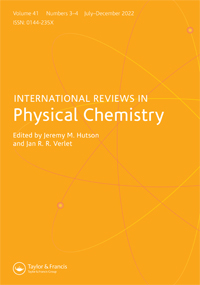共振稳定烃自由基的电子能谱
IF 2.5
2区 化学
Q3 CHEMISTRY, PHYSICAL
引用次数: 15
摘要
共振稳定的碳氢化合物自由基在火焰、等离子体、大气和星际空间中充当反应中间体。它们的稳定性是通过共轭体系使自由基电子离域而得到的。因此,它们往往具有低洼的电子态,从而产生丰富的光学光谱。在过去的六十年里,特别是在过去的十年里,人们测量了从3到17个碳原子的大量自由基的光谱。这些自由基跃迁到第一激发态的激发波长范围从紫外到近红外,跨越可见区域。本文综述了共振稳定自由基所呈现的各种发色团的电子能谱。对用于预测共振稳定自由基激发谱的理论方法进行了严格的评价,并证明了两个紧急的经验法则,它们允许人们经验地预测某些自由基的近似激发能。本文章由计算机程序翻译,如有差异,请以英文原文为准。
The electronic spectroscopy of resonance-stabilised hydrocarbon radicals
Resonance-stabilised hydrocarbon radicals serve as reaction intermediates in flames, plasmas, atmospheres and interstellar space. Their stability is conferred by delocalisation of the radical electron through a conjugated -system. As such, they tend to have low-lying electronic states which engender a rich optical spectroscopy. Over the last sixty years, and intensively over the last decade, the spectra of a great many such radicals have been measured, ranging from three to 17 carbon atoms. The excitation wavelengths of transitions to the first excited states of these radicals range from the ultraviolet to the near infrared, spanning the visible region. In this review, the electronic spectroscopy of the various chromophores presented by resonance-stabilised radicals is reviewed. The theoretical methods used to predict the excitation spectra of resonance-stabilised radicals is critically evaluated, and two emergent rules-of-thumb are demonstrated which allow one to empirically predict the approximate excitation energy of certain radicals.
求助全文
通过发布文献求助,成功后即可免费获取论文全文。
去求助
来源期刊
CiteScore
14.20
自引率
1.60%
发文量
5
审稿时长
1 months
期刊介绍:
International Reviews in Physical Chemistry publishes review articles describing frontier research areas in physical chemistry. Internationally renowned scientists describe their own research in the wider context of the field. The articles are of interest not only to specialists but also to those wishing to read general and authoritative accounts of recent developments in physical chemistry, chemical physics and theoretical chemistry. The journal appeals to research workers, lecturers and research students alike.

 求助内容:
求助内容: 应助结果提醒方式:
应助结果提醒方式:


